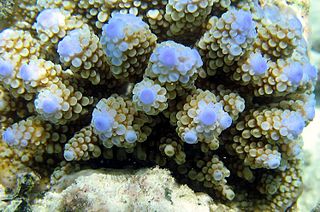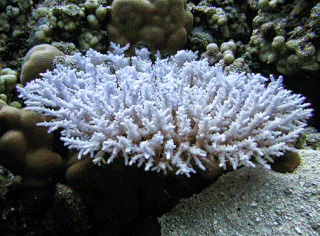
Acropora nasuta is a species of branching stony coral in the family Acroporidae. It is native to the western and central Indo-Pacific where it is found in shallow reef habitats. Like other corals of the genus Acropora, it is susceptible to coral bleaching and coral diseases and the IUCN has listed it as being "Near Threatened".

Acropora abrotanoides is a species of acroporid coral found in Indo-Pacific waters from the Red Sea and the Gulf of Aden east to the East China Sea, Japan, the central Pacific Ocean and Australia. It is found in shallow coral reefs that are exposed to the action of strong waves, at depths up to 15 m. It is vulnerable to coral bleaching, disease and crown-of-thorns starfish. It is resistant to predation as it has well-developed radial corallite lips.

Acropora digitifera is a species of acroporid coral found in the Gulf of Aden, the Red Sea, the southwest and northern Indian Ocean, Australia, southeast Asia, the central Indo-Pacific, Japan, the west Pacific Ocean and the East China Sea. It is found in shallow areas of tropical reefs in the back margins, from depths of 0 to 12 m. It was described by Dana in 1846.

Acropora gemmifera is a species of acroporid coral found in the Gulf of Aden, the Red Sea, the central Indo-Pacific, the southwest and northern Indian Ocean, southeastern Asia, Australia, the East China Sea, Japan, the oceanic central and western Pacific Ocean, and northwestern Hawaiʻi. It occurs on exposed upper reef flats and slopes, from depths of 1–15 m. It was described by Brook in 1892.

Acropora globiceps is a species of acroporid coral found in the oceanic central and western Pacific Ocean and central Indo-Pacific. It can also be found in the Great Barrier Reef, the Philippines, the Andaman Islands, Polynesia, Micronesia and the Pitcairn Islands. It occurs on the slopes of reefs, the flats of reefs, in tropical shallow reefs, and at depths of around 8 metres (26 ft). It was described by Dana in 1846.
Acropora subglabra is a species of acroporid coral found in the northern Indian Ocean, the central Indo-Pacific, Australia, Southeast Asia, Japan, the East China Sea and the oceanic west Pacific Ocean. It occurs in tropical shallow reefs, and its range is often restricted to sheltered back reefs containing soft substrates and clear water. It can be found from depths of 5 to 15 metres and was described by Brook in 1891.
Acropora teres is a species of acroporid coral found in the central Indo-Pacific, Southeast Asia, Japan, the East China Sea and the oceanic western Pacific Ocean. It is found in tropical shallow reefs on slopes and in lagoons, at depths of between 2 and 20 metres. The taxonomic status of this species is uncertain. It was described as Madrepora teres by Verrill in 1866.

Acropora valida is a species of acroporid coral found in the Red Sea, the Gulf of Aden, the southwestern, northwestern and northern Indian Ocean, the Persian Gulf, the central Indo-Pacific, Australia, southeast Asia, Japan, the East China Sea, the oceanic western, central and far eastern Pacific Ocean, the northwestern Hawaiian Islands and Johnston Atoll. It occurs in tropical shallow reefs in a variety of reef habitats, at depths of 1 to 15 metres.

Acropora verweyi is a species of acroporid coral found in the southwest and northern Indian Ocean, the central Indo-Pacific, Australia, southeast Asia, Japan, the East China Sea and the oceanic western Pacific Ocean. It is also found in the Philippines, American Samoa, Fiji and Rodrigues. It occurs in tropical shallow reefs on upper slopes, from depths of 2 to 15 metres.
Acropora abrolhosensis is a species of acroporid coral that was first described by John Veron in 1985. Found in sheltered lagoons and shallow reefs, it is listed as a vulnerable species on the IUCN Red List. The population of the species is decreasing, and most specimens are found in Western Australia, but occurs in many other areas. It is also listed under CITES Appendix II.
Acropora awi is a species of acroporid coral that was described by Wallace and Wolstenholme in 1998. Found in fringing reefs, the slopes of shallow reefs, and sandy slopes, it occurs in a marine environment. The species is rated as vulnerable on the IUCN Red List, with a decreasing population, and is easily damaged. It can be found over a large area but is not abundant.
Acropora batunai is a species of acroporid coral that was described by Carden Wallace in 1997. Found in protected, shallow reefs, it occurs in a marine environment at depths of up to 44 m (144 ft). The species is rated as vulnerable on the IUCN Red List, with a decreasing population, and is extremely fragile. It can be found over a large area but, overall, is not common.
Acropora dendrum is a species of acroporid coral that was first described by Bassett-Smith in 1890. Found in tropical, shallow reefs in areas of powerful waves at depths of 5 to 20 m, it is threatened by disease. The species is rated as vulnerable on the IUCN Red List, with a decreasing population. It is not common but found over a large area, and is listed on CITES Appendix II.
Acropora derawanensis is a species of acroporid coral that was first described by Carden Wallace in 1997. Found in tropical, shallow reefs sheltered from the waves in a marine environment, it is found at depths of 10 to 25 m on reef slopes. The species is rated as vulnerable on the IUCN Red List, with a decreasing population. It is not common but found over a large area, and is listed on CITES Appendix II. It is easily damaged.
Acropora kosurini is a species of acroporid coral that was first described by C. C. Wallace in 1994. Found in marine, shallow reefs, it occurs at depths of 8 to 20 m. It is listed as a vulnerable species on the IUCN Red List, and it is believed to have a decreasing population. It is rare but found over a large area, and is listed on CITES Appendix II.
Acropora lokani is a species of acroporid coral that was first described by C. C. Wallace in 1994. Found in marine, shallow reefs and sheltered lagoons, it occurs at depths between 8 and 25 m. It is listed as vulnerable on the IUCN Red List, and is believed to have a decreasing population. It is not common but found over a large area, including in three regions of Indonedia, and is listed under CITES Appendix II.

Acropora paniculata is a species of acroporid coral that was first described by Addison Emery Verrill in 1902. Found in marine, tropical, shallow reefs on the upper slopes, it occurs at depths of between 10 and 35 m. It is classed as a vulnerable species on the IUCN Red List, and it has a decreasing population. It is uncommon but found over a large area, including in five regions of Indonesia, and is classified under CITES Appendix II.
Acropora papillare is a species of acroporid coral that was first described by Latypov in 1992. Found in marine, tropical, shallow reefs in areas exposed to waves, it occurs at depths of between 1 and 5 m. It is classed as a vulnerable species on the IUCN Red List, and it has a decreasing population. It is uncommon but found over a large area, including in three regions of Indonesia, and is classified under CITES Appendix II.
Acropora pharaonis is a species of acroporid coral that was first described by Milne-Edwards and Haime in 1860. Found in marine, tropical, reefs on slopes sheltered from wave action, it occurs at depths of between 5 and 25 m. It is classed as a vulnerable species on the IUCN Red List, and it has a decreasing population. It is common and found over a large area and is classified under CITES Appendix II.
Acropora plumosa is a species of acroporid coral that was first described by Dr. C. C. Wallace and J. Wolstenholme in 1998. Found in marine, tropical, reefs on slopes sheltered from wave action, and on reef walls. It occurs at depths between 10 and 30 m. It is classed as a vulnerable species on the IUCN Red List, and it has a decreasing population. It is not common and found over a large area and is classified under CITES Appendix II.








